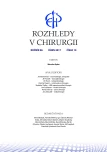Secondary peritonitis and volume therapy – single-site retrospective analysis
Authors:
E. Havel; E. Bělobrádková; P. Šafránek
Authors‘ workplace:
Chirurgická klinika LF Univerzity Karlovy a FN Hradec Králové
přednosta: doc. MUDr. J. Páral, Ph. D.
Published in:
Rozhl. Chir., 2017, roč. 96, č. 10, s. 421-425.
Category:
Original articles
Overview
Introduction:
Secondary peritonitis is a typical surgical intensive care situation. Leakage of fluid into the interstitial space and peritoneal cavity requires adequate fluid resuscitation to optimize the hemodynamic stability. The aim of the study is to present specific volumes of fluid transfer in situations of acute peritonitis based on a single-site retrospective analysis of volume therapy in patients with this condition.
Methods:
Retrospective analysis of patients with secondary peritonitis treated at ICU-1 of the Surgical Department of the University Hospital in Hradec Kralove between 2013−2016. Volume therapy was provided using balanced crystalloids and was monitored based on dynamic hemodynamic indicators (variations of the pulse waveform, response to fluid challenge, physical examination). Fluid balance was managed by intake and output measurements and by estimating immeasurable losses.
Results:
We evaluated the set of 139 patients with severe secondary peritonitis according to the Mannheim Peritonitis Index (MPI) 27.9 and predicted lethality 26%. The lethality actual was 24%. Hemodynamic stabilization was associated with the mean cumulative positive fluid balance of 8643 ml, which peaked after 1.83 day from admission. The average length of ICU stay was 8 days. Blood pressure support with norepinephrine was necessary in 42% of patients and lasted the mean of 32 hours. None of the patients was on dialysis; in two cases, kidney failure occurred in a situation of generalized cancer and intractable vascular ileus.
Conclusion:
Peritonitis leads to significant leakage of fluids into the third space, and in surgery, it is one of conditions characterized by the highest need of fluid therapy in the resuscitation phase of sepsis and septic shock. The risk of underestimating fluid therapy is high in practice.
Key words:
peritonitis − septic shock – fluid optimization − positive fluid balance
Sources
1. Majtan P, Neumann J, Kocián P, et al. Perspektiva pacientů operovaných pro sekundární peritonitidu. Rozhl Chir 2015;94 : 199−202.
2. Doklestič SK, Bajec DD, Djukič RV. Secondary peritonitis – evaluation of 204 cases and literature review. J Med Life 2014;7 : 132−8.
3. Menclová K, Traboulsi E, Nikov A, et al. Léčba akutní apendicitidy: retrospektivní analýza vlastního souboru. Rozhl Chir 2016;95 : 317−21.
4. Sun D, Wang C, Yang L, et al. The predictors of the severity of ischaemic colitis: a systematic review of 2823 patients from 22 studies. Colorectal Dis 2016;18 : 949−58.
5. Daher R, Barouki E, Choulliard E. Laparoscopic treatment of complicated colonic diverticular disease: A review. World Journal of Gastrointestinal Surgery 2016;8 : 134−42.
6. Barbieux J, Plumereau F, Hamy A. Current indications for the Hartmann procedure. J Visc Surg 2016;153 : 31−8.
7. Gürlich R, Adámková V, Ulrych J, et al. Základní principy diagnostiky a léčby sekundární peritonitidy – doporučení odborníků s podporou SIS. Rozhl Chir 2014;93 : 322−49.
8. Sartelli M, Viale P, Catena F, et al. 2013 WSES guidelines for management of intra-abdominal infections. World J Emerg Surg 2013;3 : 1−29.
9. Ihnát P, Peteja M, Vávra P, et al. Současné trendy v péči o pacienty s břišní sepsí. Rozhl Chir 2015;94 : 234−7.
10. Slaninka I, Páral J, Chobola M, et al. Peritonitidy způsobené perforací trávicí trubice – analýza gerontologické skupiny pacientů. Rozhl Chir 2009;88 : 656−61.
11. Billing A, Fröhlich D, Schildberg F. Prediction of outcome using the Mannheim peritonitis index in 2003 patients. Peritonitis Study Group. Br J Surg 1994;81 : 209−13.
12. Weber DG, Bendinelli C, Balogh ZJ. Damage control surgery for abdominal emergencies. Br J Surg 2014;101 : 109−18.
13. Singer M, Deutschman CS, Seymour CW, et al. The Third International Consensus Definitions for Sepsis and Septic Shock (Sepsis-3). JAMA 2016;315 : 801−10.
14. Horák J, Harazim M, Karvunidis T, et al. Sepse – jak ji poznat, na co se zaměřit aneb zpět k základům ve světle nové definice. Vnitř Lék 2016;62 : 568−74.
15. Rhodes A, Evans LA, Alhazzani W, et al. Surviving sepsis campaign: International guidelines for management of sepsis and septick shock: 2016. Intensive Care Med 2017;43 : 304−77.
16. Ordonez CA, Puyana JC. Management of peritonitis in critically ill patient. Surg Clin North Am 2006;86 : 1323-49.
17. Hoste EA, Maitland K, Brudney CS, et al. Four phases of intravenous fluid therapy: a conceptual model. British Journal of Anaesthesia 2014;113 : 740−7.
18. Bleszynski MS, Chan T, Buczkowski AK. Open abdomen with negative pressure device vs primary abdominal closure for the management of surgical abdominal sepsis: a retrospective review. The American Journal of Surgery 2016;211 : 926−32.
19. Rezendo-Neto J, Rice T, Abreu ES, et al. Anatomical, physiological, and logistical indications for the open abdomen: a proposal for a new classification system. World Journal of Emergency Surgery 2016. Available from: http://wjes.biomedcentral.com/articles/10.1186/s13017-016-0083−4.
20. Weber DG, Bendinelli C, Balogh ZJ. Damage control surgery for abdominal emergecies. BJS 2014;101:e109−18.
21. Vyhnánek F. Akutní chirurgická péče – jak dál? Rozhl Chir 2016;95 : 255−6.
22. Doklestic SK, Bajec DD, Djukic RV, et al. Secondary peritonitis – evaluation of 204 cases and literature review. Journal of Medicine and Life 2014;7 : 132−8.
23. Ruggiero R, Sparavigna L, Docimo G, et al. Post-operative peritonitis due to anastomotic dehiscence after colonic resection. Multicentric experience, retrospective analysis of risk factors and review of the literature. Ann Ital Chir 2011;82 : 369−75.
Labels
Surgery Orthopaedics Trauma surgeryArticle was published in
Perspectives in Surgery

2017 Issue 10
Most read in this issue
- Complicated intraabdominal infections in surgical patients–empiric antimicrobial therapy management
- Clostridium difficile remains a medical challenge
- Bleeding during anticoagulant and antiaggregation therapy as a cause of acute abdomen
- Treatment of locally advanced rectal cancer – is it time for a change?
